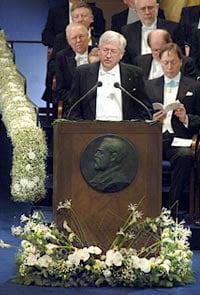Award ceremony speech
Presentation Speech by Professor Per Ahlberg, Member of the Royal Swedish Academy of Sciences, Member of the Nobel Committee for Chemistry, December 10, 2005.
 |
| Professor Per Ahlberg delivering the Presentation Speech for the 2005 Nobel Prize in Chemistry at the Stockholm Concert Hall. Copyright © Nobel Media AB 2005 Photo: Hans Mehlin |
Your Majesties, Your Royal Highnesses, Ladies and Gentlemen,
This year’s Nobel Laureates in Chemistry have created fantastic opportunities to build new organic molecules. It is easy to see why this is important. It is among such molecules that we are finding new materials and new medicines, and developing methods to do old things better.
Organic compounds contain the element carbon. Carbon atoms can bind to each other to form long chains and rings, but they can also bind to other elements such as hydrogen, oxygen and nitrogen to form very complex compounds. All life on earth is based on nature’s own carbon compounds but these and other organic compounds can be made artificially using organic synthesis. The diversity of organic molecules is enormous. So far only a small proportion of all the possible organic molecules have been investigated. Nevertheless we have already obtained new medicines, new materials and new surface coatings undreamed of a few years ago.
The achievements of this year’s Laureates have given us one of the most important methods for building new organic molecules – metathesis. The word metathesis means change places. In metathesis double bonds between carbon atoms are broken and the parts are paired together in a new way. This does not happen by itself. It takes place with the help of the special molecular tools – catalyst molecules – that the Laureates have developed. The phenomenon of metathesis was discovered in the nineteen-fifties in the polymer industry, but nobody knew what the catalyst looked like, or how it worked: just that it did work. However, awareness of the opportunities offered by metathesis for constructing new organic compounds was developing.
A number of researchers made proposals about how metathesis works. The breakthrough came in 1971 when Yves Chauvin presented new experiments and suggested that the catalyst is a carbon/metal compound in which the metal is bonded to carbon with a double bond. Chauvin also presented a novel mechanism for how the catalyst works in metathesis.
The mechanism resembles a dance. The catalyst, in which the metal holds its carbon partner with both hands, “dances” among carbon/carbon pairs, which are molecules with carbon-carbon double bonds. When the “catalyst pair” meets a carbon/carbon-pair, the two dancing pairs unite in a round dance. After a while they let go of each other’s hands, leave their old dance partners and dance along with their new ones. The new “catalyst pair” is now ready to catch another dancing carbon/carbon pair for a new round dance. In other words it continues to act as a catalyst for metathesis.
By combining parts of different molecules in this way new molecules with new properties are created. One example of this is biologically active molecules that can function as medicines.
Chauvin’s results opened the way for the design and construction of catalysts. Now, the big question concerned the detailed catalyst design required to obtain efficient catalysts for metathesis. The critical progress was made by Richard Schrock and Robert Grubbs.
Schrock, who initiated his basic research in the early nineteen-seventies, used a number of different metals in his investigations. Gradually he discovered which metals worked the best and how the other parts of the catalyst should be constructed. A breakthrough came in 1990 when Schrock presented a group of very active catalysts containing the metal molybdenum.
A new breakthrough came in 1992 when Grubbs published his discovery of a catalyst based on the metal ruthenium. Grubbs’ catalysts are stable in air and show higher selectivity but have lower reactivity than Schrock’s catalysts. They have become the first well-defined catalysts for general use in metathesis in ordinary laboratories, and new visions of the opportunities of organic synthesis have emerged from their use. Today metathesis is used in the pharmaceuticals, foodstuffs, chemical, biotechnical, polymer and paper industries. Metathesis also saves energy and material, and is kind to the environment. It takes us a step towards a “greener” future.
Dr. Chauvin, Dr. Grubbs, Dr. Schrock, I have briefly described your basic research. It has led to the efficient metathesis catalysts that have become such revolutionary general tools in organic synthesis, and that have changed our thinking about how to make molecules. Your achievements make it easy to answer the question: to what use can science be put? They are also entirely in the spirit of Alfred Nobel.
On behalf of the Royal Swedish Academy of Sciences I wish to convey our warmest congratulations to you, and I ask you to step forward to receive the Nobel Prize from the hands of His Majesty the King.
Nobel Prizes and laureates
Six prizes were awarded for achievements that have conferred the greatest benefit to humankind. The 14 laureates' work and discoveries range from quantum tunnelling to promoting democratic rights.
See them all presented here.
